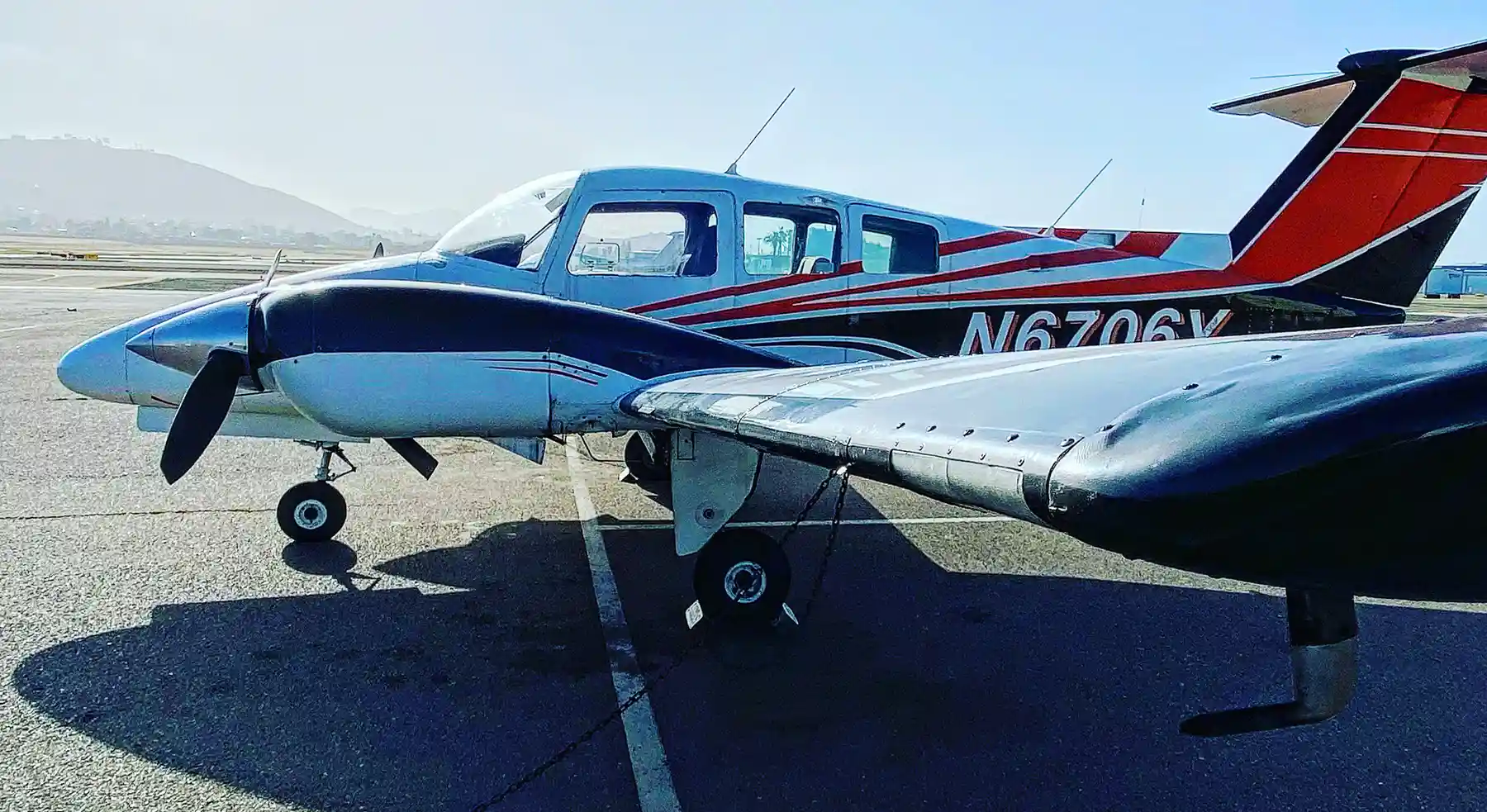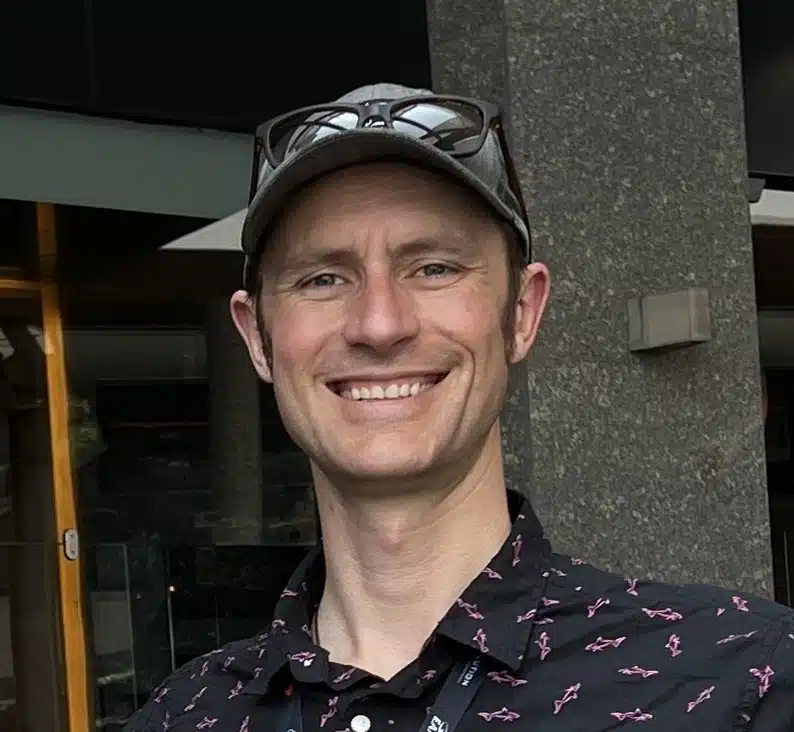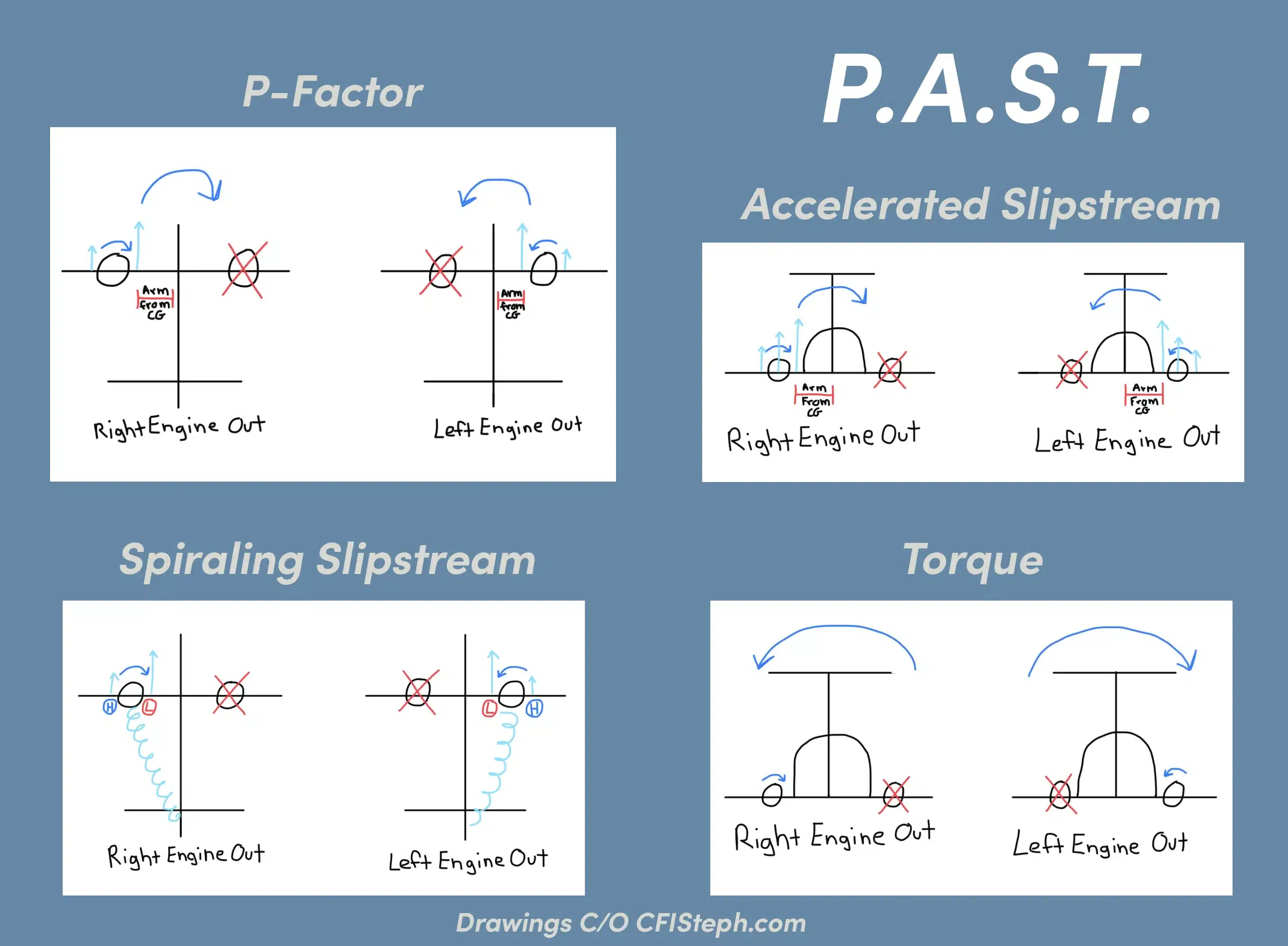PAST and COMBATS: Multi-Engine Rating Memory Items to Know

Stepping up to a Multi-Engine Rating as a pilot is exciting. You get more power, range, and double the things that can go wrong with two engines. Yay!
A crucial part of learning to fly a twin aircraft is knowing what performance is like with an engine quits. There are two multi-engine rating memory items that will help you both understand and appreciate the power — and danger — two engines provide.
While not as taxing as an Instrument or a Commercial Rating, learning the ropes of a multi-engine can be daunting at first. "P.A.S.T.? C.O.M.B.A.T.S.? V-em-what?" Not to worry, let's break these core concepts of multi-engine flight down for you so that you can master this next step in your piloting evolution!
What Happens to a Multi-Engine Plane with an Engine Quits
If one of your engines in a multi-engine aircraft dies and you don't respond correctly, the thrust of the good engine and the drag of the dead engine will cause significant yaw and roll movements which could put you in a spin and/or flip/upset which you may not recover from.
Improper and poorly timed recovery from engine outs have claimed many pilots' and passengers' lives. Thankfully, aircraft manufacturers, the FAA, and flight instructors know why these accidents happen and how to prevent them, and you knowing them is part of the Airman Certifications Standard (ACS).
Before we dive in, it helps to know that there are two types of twin engine piston aircraft: conventional twins and counter-rotating twins.
A conventional twin engine aircraft simply means it has two engines whose propellers turn in the same direction (clockwise when viewed from inside the cockpit).
A counter-rotating twin engine aircraft has both engines turning toward the nose or longitudinal axis of the aircraft (i.e. the left engine turns clockwise and the right engine turns counter-clockwise when viewed from the pilot's seat).
Multi-Engine Rating Memory Items to Know
P.A.S.T.
P.A.S.T. is a memory aid and acronym that stands for four factors that cause conventional multi-engine aircraft with one engine inoperative to behave dangerously. Each factor contributes to either yaw and/or roll which — if in great enough quantity or power, and slow enough speed — will lead to a crash. These factors impact a counter-rotating twin as well, but not to the same degree thanks to their opposing prop rotations.
P-Factor
You should be very familiar with P-factor as a student or private single engine pilot. If not, P-factor is the asymmetric thrust of the descending propeller blade (if looking from the cockpit ahead, the blade positions at 3–6 o'clock) when at high power and high angles of attack. You experience P-factor usually on take off which requires a lot of what? That's correct, you need substantial right rudder to keep the plane aligned with the runway to prevent veering off to the left.
While P-factor is strong in a single engine, P-factor in a conventional multi-engine aircraft is a BIG deal. So big that the left engine is called the critical engine in a conventional twin (again, this is the left engine from the pilot's seat perspective). It's critical because if you lost the right engine and had the left, the impact of P-factor and the other factors we mention below aren't as pronounced.
When the left engine quits or dies, the right engine's descending propeller blade creates more P-factor because it is farther from the lengthwise centerline of the aircraft. This longer moment arm (or leverage) creates a greater yaw than an engine spinning it's blades toward the aircraft's nose.
Counter-rotating multi-engines still have P-factor to deal with, but the yawing impact is easier to control.
Accelerated Slipstream
When one engine is operating and one is inoperative (a.k.a. dead), what's happening with thrust and drag? Simple, one engine (the working one) is creating thrust while the busted one (the inoperative one) is creating massive drag windmilling in the air.
Single engine aircraft experience accelerated slipstream but to a limited degree given where the engine is located. Twins, on the other hand, have their engines usually mounted into, onto, or under the wing. The thrust produced by the spinning prop accelerates wind over the airfoil, and we know what happens when air moves fast over a wing, right? It produces lift!
So, we've got one wing lifting while the other is getting air braked by a windmilling prop. That creates a roll towards the dead engine which lifts the operative engine's wing. If left uncontrolled, this increases the bank which builds horizontal lift and angles of attack which increase stall speed. No bueno.
Spiraling Slipstream
Another one from single-engine training! A spiraling slipstream (I've heard is up to some debate, so take it to the comments if you care) is the spiraling wind pattern produced by a spinning propeller. It travels in a helix or spiral in the same direction of rotation that the prop rotates. As this spiral moves aft it strikes the vertical stabilizer and pushes on it causing a yawing moment opposite the prop's direction of rotation. Another reason we need right rudder under high power like during take off and climb.
In a conventional multi-engine, the spiraling slipstream is useful if the right engine dies because the left prop's wash strikes the tail and counteracts the yaw toward the dead engine.
If the right engine is the only one working, its spiraling slipstream hits nothing but air will not help the pilot by reducing adverse yaw.
Torque
In Newtonian physics, we have Newton's third law of motion which states that every action produces an equal and opposite reaction. If our propellers are turning to the right, then the equal and opposite reaction is the rest of the aircraft rolling to the left.
Not a big deal if the left engine is working since the torque counteracts the tendency to roll towards the inoperative engine. But if the left engine quits, then there is no counteraction to stop the roll towards the dead (left) engine.
So, using the memory aid of P.A.S.T. can help you recall the four things that make a critical engine out scenario very dangerous in a conventional multi-engine aircraft and allows you to communicate to your Designated Pilot Examiner (DPE) that you understand some core risks of engine-out multi-engine flying.
P.A.S.T Illustrations by CFISteph
C.O.M.B.A.T.S. & VMC
The next acronym helps you memorize the seven conditions that aircraft manufacturers must demonstrate in their twin engines planes during F.A.A. certification (VMC Factor FAA Demonstration, as required by 14 CFR 23.149).
A crucial aspect of this certification is determining minimum controllable airspeed, or VMC. This is the speed at which, under the following conditions, the plane will be uncontrollable if flown any slower than VMC.
Critical Engine Inoperative & Windmilling
Before aircraft with counter rotating props came along, there was a critical engine. If you lost that engine, like we saw earlier, you'd find that trying to control the plane was much more difficult than if you lost the non-critical engine. Cowl flaps are also open.
The critical engine is usually the left engine in conventional rotating twins and this is the engine that needs to be disabled and be windmilling (i.e. not feathered) for certification.
Operating Engine at Full Power
With the critical engine at idle and windmilling, we now need our operating (i.e. working) engine at full power. This whole test is done to emulate one of the riskiest scenarios for losing an engine: at take off.
MAXIMUM UNFAVORABLE Weight
Usually maximum takeoff weight (MTOW). This is supported by the notion that all V speeds are computed at max gross weight unless specified otherwise in the POH. The term "most unfavorable weight" is interpreted in the context of performance rather than VMC.
This test intentionally degrades the power performance by taking off at max gross weight, challenging the operating engine's capabilities. This approach helps identify the aircraft's performance limitations. While some may argue that "maximum unfavorable weight" means the lightest permissible weight, the focus is on determining the slowest speed at which the multi-engine aircraft can maintain control under the most challenging conditions, such as raising the gear after takeoff from a sea-level airport at MTOW with an aft CG. Blueline and Vmc calculations are based on this extreme scenario.
Bank Into Operating Engine by 5°
A crucial step in any single-engine flight, banking into the working engine helps reduce the side of the fuselage flying into the relative wind and decreasing performance. It's a key part of directional control when losing an engine so they include it in the test.
Aft-most Center of Gravity (CG)
This criteria helps demonstrate the limits of rudder effectiveness and increases instability.
With the CG being so far aft (i.e. back towards the tail), the lever arm impact of rudder inputs to control yaw is reduced significantly. This helps place the plane's performance on the edge of availability (yes, new word).
Takeoff Configuration
Flaps are down and extended to create a high drag condition and simulate the conditions during takeoff. Gear, however, is not required to be down according to FAR 24.19(c)(5).
Note: An extended gear can actually help stabilize the aircraft because it will act like a keel to counteract the thrust and yawing tendencies experienced in single-engine flight.
Standard Temperature Day: Temp & Pressure
This one is just to establish a baseline, and what better baseline than ISA of 15°C and 29.92 inches of mercury?
Tips for Recovery Near VMC Red Line Speed in Twin-Engine Aircraft
Flying a twin-engine aircraft requires careful attention to various factors, and one critical consideration is staying clear of VMC, the minimum controllable airspeed with one engine inoperative. Here are three essential tips to help you recover when nearing the VMC red line speed:
1. Maintain a Safe Speed Margin
Ensure you maintain a comfortable distance from the red line speed. Speed is crucial in preventing the onset of VMC conditions. By flying at a greater distance from the red line, you provide yourself with more reaction time and increase the margin of safety.
2. Reduce Operating Engine Thrust
If you find yourself approaching Vmc speed, one effective way to regain control is by reducing the thrust on the operating engine. This action helps minimize yaw, making it easier to manage the aircraft. By promptly adjusting the operating engine's thrust, you can counteract the effects leading to VMC conditions.
Be on the lookout for partial power loss, too. Move smooth and slow when identifying and verifying your inoperative engine!
3. Utilize Altitude for Recovery
Altitude is your ally in overcoming VMC challenges. If you're nearing the red line speed, consider pitching down to gain speed. Altitude provides the flexibility to adjust your pitch, aiding in the recovery process. Being at a higher altitude allows you to make controlled maneuvers and regain a safer airspeed.
Remember, these tips are essential for recovery in critical situations, and thorough training on the specific characteristics of your twin-engine aircraft is crucial. By staying vigilant and practicing these recovery techniques, you enhance your ability to handle challenges near VMC speed and ensure a safer flying experience.
Now, drill them!
As with any checkride or examination in aviation, practice and preparation are essential. Use an app like Quizlet or normal index cards and create flashcards to practice these acronyms.
I also like to move my body or chair-fly as I'm visualizing the concepts for each letter. Move your arms, head, feet to simulate how it feels in the plane as these forces or situations feel.
Good luck with your checkride prep and enjoy every minute of flight you get!
Multi-Engine Memory Items to Know Recap
When flying a twin-engine airplane, how you handle an engine failure depends on whether your aircraft has conventional or counter-rotating engines. In a conventional twin, both engines spin in the same direction. This means that if one engine fails—especially the left one—the other engine creates stronger yaw and roll forces, making the plane harder to control. This is because of the way the air pushes on the aircraft, causing it to turn more aggressively in one direction. In a counter-rotating twin, each engine spins toward the nose, balancing out some of these forces. While losing an engine is still a big deal, it doesn’t cause as much yaw or roll, making it a little easier to keep the plane steady. However, the key memory items still apply to both aircraft types, since you always have to deal with extra drag from the dead engine and adjust your rudder and bank angle to stay in control.
The environment also plays a huge role in how well your plane performs when an engine quits. In hot weather or at high altitudes, the air is thinner. This means the engines don’t produce as much power, the propellers don’t grab as much air, and the wings generate less lift. If you lose an engine in these conditions, it’s harder to climb or even maintain altitude. The aircraft's minimum controllable speed (V_MC) could also be higher because the air isn’t helping as much with control. This means a pilot needs to act even faster and be extra precise with their response to avoid losing control. If an engine fails during takeoff at a high-altitude airport on a hot day, the plane might not be able to climb at all—making it even more important to recognize the problem immediately and follow the correct memory items.
To really master these emergency procedures, pilots should practice beyond just reading flashcards or thinking through the steps. Flight simulators are one of the best ways to train because they let you experience an engine failure in real time without any real danger. You can also use video tutorials, interactive apps, or virtual reality simulations that put you inside the cockpit for hands-on practice. Even using a small flight training device at home can help reinforce the muscle memory needed to respond quickly. The more a pilot practices in realistic settings, the more automatic these emergency procedures become—so when an actual engine failure happens, they don’t have to think; they just react the right way.

Tigre Pickett
CE525S / Commercial Pilot / AGI IGI
Tigre's airtime began when his mother achieved her Private Pilot's License eight-months pregnant with him. Since then, he's learned to fly with his father, Rich Pickett, and now works with him as Chief Co-Pilot and Creative Director for Personal Wings.
After working in a variety of other industries, Tigre recently set his sights on becoming a professional pilot and within seven months achieved his first jet type rating in the Citation 525 series aircraft and now flies two Citations under Part 91.
A father, husband, and all around talented man, Tigre is excited to see all of his family achieve their wings!
